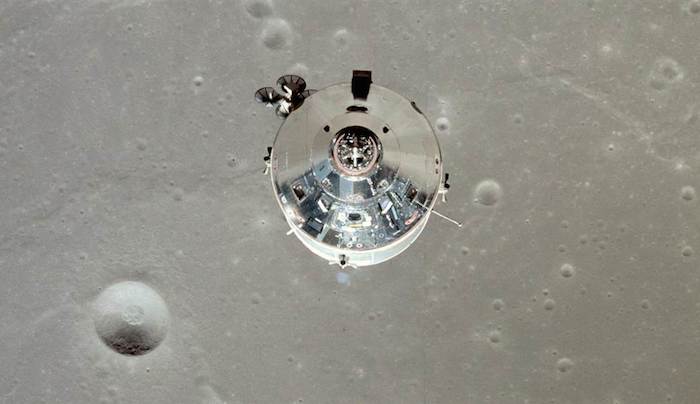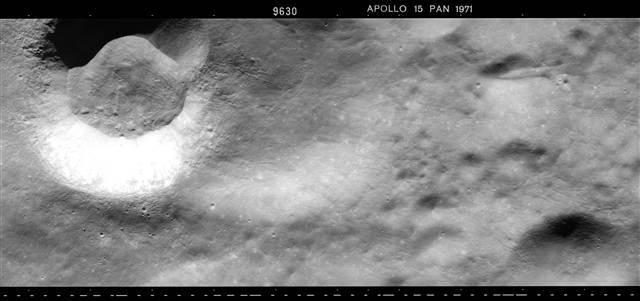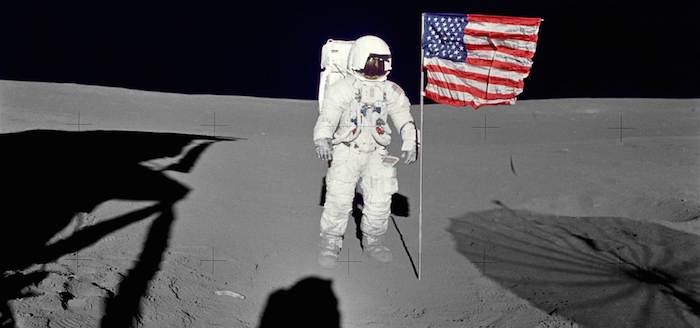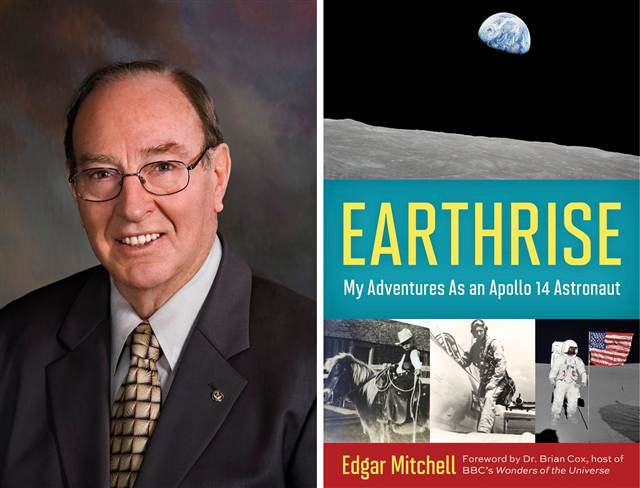.
19.07.2014

The pixels in a photograph can be funny things, as demonstrated time and time again in "Aliens on the Moon: The Truth Exposed," a TV documentary airing on Sunday's 45th anniversary of the historic Apollo 11 moon landing.
What one person sees as a overly magnified image with distortions that merely form strange patterns, another person sees as incontrovertible proof that extraterrestrials have left giant antennas, spaceships and industrial complexes on the moon.
"There's no doubt that these structures exist," Robert Kiviat, producer of the two-hour SyFy Channel show, told NBC News. (NBC News Digital and SyFy are both part of NBC Universal.)
Is Kiviat serious? He sounds like it. "My goal would be, right upon the airing on Sunday night, maybe even the day after, to approach the NASA administrator in Washington ... and pretty much say, 'Look, here are these photographs, here's what we know from the NASA data, we would love to work with this under NASA auspices,'" he said.
NASA Administrator Charles Bolden might not rush to join the search for aliens on the moon, but that sort of quest is right up Kiviat's alley. He was behind the "Alien Autopsy" TV show that made such a splash in 1995 with purported footage of alien bodies from Roswell. The footage was later proven to be fake, but in his defense, Kiviat says he acknowledged that in follow-up programs.
"I'm not telling you that I'm ashamed of my work on that," he said. "I'm not."
.
Photos old and new
The heart of "Aliens on the Moon" is a review of decades-old photographs from the Apollo missions, with commentary by sources ranging from former Apollo astronauts Buzz Aldrin and Edgar Mitchell to old standbys on the UFO scene (MUFON analyst Marc D'Antonio, "Dark Mission" co-author Mike Bara and physicist John Brandenburg, plus photo lab workers Donna Hare and Ken Johnston).
First, about those photographs: Many of the cases have long been part of Apollo UFO lore, and have been addressed on websites such as The Emoluments of Mars. It's fun to see those cases reviewed, as long as you know the history.
Watch for the case of the Asada Crater satellite dish, the tale of the lunar pyramid (also known as the Daedalus ziggurat), the picture of the Apollo 17 skull (also known as Data's Head) and the paperclip on the moon (which has been traced to lint on the picture). Rational Wiki lists the greatest hits on the lunar anomaly list.
.

The shape at upper right in this photo from Apollo 15 has been characterized as a cigar-shaped UFO, but a closer look reveals it to be a straightforward geological feature. The picture is part of a panoramic photo known as AS15-P-9630.
.
Attention is given to a cigar-shaped UFO on the moon, as well as the related story of the Apollo 20 / Mona Lisa hoax. No need to go into detail on all this — watch the show, then follow the links for outside critiques.
"Aliens on the Moon" spends a lot of time on a picture from Apollo 11 that Kiviat calls the "smoking gun" for an alien presence on the moon. The original photo, AS11-41-6139, is relatively unremarkable — but if you blow it up enough, the pixels take on a loopy appearance that the show's experts see as a flying saucer.
"Aliens on the Moon" makes a strong pitch for revisiting the moon, and you don't have to be a UFO fan to hope that eventually happens. But many of the show's seemingly baffling mysteries can be resolved much more easily, by looking at higher-resolution imagery from NASA's Lunar Reconnaissance Orbiter. For example, straight-line tracks that UFO fans might interpret as evidence of massive machines on the moon are more clearly seen as the result of rolling boulders.
Where the astronauts stand
Now, about those astronauts: The show makes it sound as if Aldrin was reluctant to talk about potential UFO sightings — and it's true that he turned down an invitation to review and comment in detail about the Apollo photographs. But over the years, he has discussed the sighting of what the Apollo 11 crew thought at the time was an unidentified flying object in the literal sense of the phrase.
This month, during a Reddit online chat, he passed along the mainstream view once again. "It was either the rocket we had separated from, or the four panels that moved away when we extracted the lander from the rocket and we were nose to nose with the two spacecraft," he said. That view gets short shrift in the show.
Mitchell, meanwhile, has made no secret of the fact that he believe extraterrestrials exist. "I have no doubt that extraterrestrials could very well have populated or made structures on the far side of the moon," the Apollo 14 moonwalker says on the show.
"Twists and distortions do take place, and I don't know how to stop them."
However, Mitchell also has acknowledged that neither he nor any of his colleagues among the Apollo astronauts found any evidence of aliens on the moon. That part of the message often gets left out, much to Mitchell's dismay.
"Twists and distortions do take place, and I don't know how to stop them, except not to give any interviews," Mitchell told NBC News in an email. "Any help is appreciated."
NBC News' space analyst, James Oberg, worries that UFO-centric interpretations and claims about coverups go unchallenged on the show. "I am appalled by the lack of any concern for verification of eyewitness claims," he said in an email. "The producers don't want to know contrary views, they act as if they want to not know such views."
He said that UFO documentaries could end up holding back the honest-to-goodness search for alien life if they put too much emphasis on funny pixels from decades-old pictures, or give too much credence to twisted tales from questionable sources.
"Someday our space explorers — human or surrogate — likely will come across something of non-natural, non-human origin in space," Oberg said. "By making the concept the subject, in this case, of well-deserved ridicule, it is part of the problem, not part of the solution, to the challenge of detection and recognition of traces of extraterrestrial intelligence."
Quelle: NBC
.
Update: 26.07.2014
.
Apollo 14 Astronaut Ed Mitchell Blick nach oben: UFOs und darüber hinaus:
.

Apollo 14 moonwalker Edgar Mitchell may be the only astronaut to conduct an ESP experiment in space, or openly state that extraterrestrials could theoretically live on the moon. But when historians look back at the Apollo moon effort a thousand years from now, Mitchell wants to be remembered for the down-to-Earth attitude he took toward his assigned task on the moon.
"Our task was to start to do the science," he told NBC News. "And we did that. We did it well. We brought back the first real samples from the moon."
Sure, Apollo 11 brought about 50 pounds of moon rocks back to Earth, and Apollo 12 brought back 75 pounds. As most folks will recall, a potentially fatal mishap forced Apollo 13 to come back from the moon without ever landing on its surface — which meant the pressure was on Mitchell and his Apollo 14 crewmates, Alan Shepard and Stuart Roosa, to help get America's space program back on track in 1971.
The mission succeeded, though not without a hitch or two ... or three. In his recently published book, "Earthrise: My Adventures as an Apollo 14 Astronaut," Mitchell recounts all the twists and turns that brought him from farm life near Roswell, New Mexico, to the moon and back.
Science and sports
Mitchell argues that Apollo 14 marked the transition from just proving humans could make it to the moon, to conducting a rigorous scientific program to characterize the lunar surface. Mitchell and his commander, Alan Shepard, brought back 94 pounds of moon rocks from the Fra Mauro formation, including a famous 20-pounder that was nicknamed "Big Bertha."
They also made their mark as the first sportsmen on the moon: Shepard carried a jury-rigged golf club and hit a ball that went "miles and miles and miles," while Mitchell picked up a rod from a solar-wind experiment and threw it like a javelin.
"I've always been happy to say that my javelin landed a few inches farther than Alan's golf ball," Mitchell says in the book. The place where it landed is now known as Javelin Crater (not Golf Ball Crater).
Back to the moon?
This week marked the 45th anniversary of the first steps taken on the moon, and the occasion has sparked lots of discussion about whether and how we should go back. Mitchell doesn't think a return trip is necessary, unless it somehow helps further other goals on Earth or elsewhere in space.
"As far as a nice place to live, it doesn't have much to offer," he said jokingly.
The way Mitchell sees it, humanity's push outward into space needs to be part of a bigger picture, focusing on the sustainability of humanity and the rest of Earth's species. "I think a big problem on Earth right now is our lack of movement toward sustainability," he told NBC News. "We're not sustainable on this planet."
.

Apollo 14 moonwalker Edgar Mitchell is the author of "Earthrise."
.
Speaking of sustainability, Mitchell said he's not surprised to see how long it's taken for human spaceflight to turn into a viable commercial enterprise. After all, it took decades for automobiles to progress from the first vehicle to a full-fledged industry, or for the aviation industry to go from the Wright Brothers to the first commercial airline terminal.
"The same thing's kind of happening in space, now that we have Elon Musk and Richard Branson and Bob Bigelow, all trying to do something to get private industry into space," Mitchell said. "Maybe that's just the pattern of things when entrepreneurship starts to take over."
Mars could be a valid frontier for the future, in Mitchell's view. He recalled that while he was getting his doctoral degree at the Massachusetts Institute of Technology in the 1960s, he came up with a guidance system for low-thrust interplanetary spacecraft. "That was my contribution to going to Mars," he said.
Experiencing the Overview Effect
The experience of being on the moon was life-changing for Mitchell. "We were the third manned mission to make it to the moon, and it felt tremendous," he writes. But the epiphany that Mitchell experienced during the flight back home from the moon was arguably even more of a life-changer.
As Mitchell gazed at Earth, suspended in the palpable blackness of space, he felt a deep, ecstatic rush of connectedness with the rest of the universe. "What the heck is happening to me?" he recalls asking himself at the time.
He eventually learned that other space travelers felt a similar cognitive shift, known as the "Overview Effect." Seeing the home planet in the void can spark a sense of oneness and enlightenment that is often described using terms from Hinduism, Buddhism and other spiritual disciplines.
The long-range ESP experiment he conducted during his personal time on Apollo 14's trip to and from the moon reinforced his interest in the frontiers of perception. He wrote down sets of numbers and symbols during specific times, to see if four experimental subjects on Earth would write down anything similar.
The idea that telepathy exists hasn't gained much traction in the scientific community, but Mitchell saw the results as promising. "The experiment persuaded me that ESP could happen," he writes in the book. He retired from NASA and the U.S. Navy soon after his moon mission, and founded the Institute of Noetic Sciences in 1973.
Mitchell makes no secret about his belief that life exists elsewhere in the universe, and he's willing to accept the possibility that alien spacecraft have visited Earth. When he returned to his hometown in New Mexico, he met with the relatives and colleagues of people involved in the 1947 Roswell UFO incident — and decided there was 'adequate proof that the Roswell incident was a real thing."
He also acknowledges, however, that he has no firsthand experience when it comes to aliens or UFOs. Instead, he prefers to address the "life in the universe" question more generally, based on the discoveries made by planet-hunting efforts such as NASA's Kepler mission.
"We're just one tiny grain of sand on a virtually infinite beach," Mitchell said. "The notion that we're alone in the universe, that we're the only living species, is absolutely ridiculous. ... Our whole idea of what it means to be living on this planet, and even being a thinking human on this planet, is going to have to undergo some major revision."
Quelle: NBC
4793 Views

